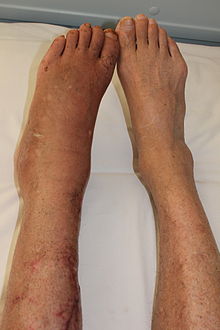User:Mr. Ibrahem/Complex regional pain syndrome
| Complex regional pain syndrome | |
|---|---|
| Other names | Reflex sympathetic dystrophy (RSD), causalgia,[1] reflex neurovascular dystrophy (RND) |
 | |
| Left leg affected by complex regional pain syndrome following a tibial bone fracture. | |
| Specialty | Neurology, anesthesiology |
| Symptoms | Region of pain, swelling, skin changes, limited range of motion, temperatures changes[2] |
| Duration | Short or long-term[1] |
| Types | Type I, type II[2] |
| Causes | Following tissue injury[2] |
| Risk factors | Psychological stress[2] |
| Diagnostic method | Based on symptoms after ruling out other potential causes[2] |
| Differential diagnosis | Neuropathy, cellulitis, erythromelalgia, vasculitis, chronic venous insufficiency, lymphedema, deep vein thrombosis, Raynaud’s, porphyria[2] |
| Treatment | Physiotherapy, medications, cognitive behavioral therapy[2] |
| Prognosis | Variable[1] |
| Frequency | 6 per 100,000 people per year[2] |
Complex regional pain syndrome (CRPS) is a condition characterized by prolonged and excessive pain and inflammation following an injury.[1] Other symptoms often include swelling, skin changes, limited range of motion, and temperatures changes in the affected area.[2] Most commonly it starts in a limb though may spread to other areas.[2]
It is unclear why CRPS occurs.[1] The trigger is typically some type of tissue injury, most commonly a bone fracture.[2] Risk factors include psychological stress.[2] The underlying mechanism involves abnormal neuronal transmission, autonomic dysregulation, and central sensitization.[2] It is a type of neuropathic pain of which there are two subtypes.[2] Diagnosis is based on symptoms after ruling out other potential causes.[2]
Evidence for specific treatments is overall poor.[3] Different measures may include physiotherapy, cognitive behavioral therapy, steroids, gabapentin, duloxetine, lidocaine patches, opioids, ketamine, bisphosphonates, and nerve blocks.[2][3] Components of physiotherapy may include graded motor imagery and mirror therapy.[3] Outcomes are variable.[1]
CRPS newly affects about 6 per 100,000 people per year.[2] Women are three times more commonly affected than men.[2] Onset is often around the age of 40.[1] The condition was first described in 1864 by Silas Weir Mitchell.[4]
References[edit]
- ^ a b c d e f g "Complex Regional Pain Syndrome Fact Sheet | National Institute of Neurological Disorders and Stroke". www.ninds.nih.gov. Retrieved 9 March 2021.
- ^ a b c d e f g h i j k l m n o p q r Guthmiller, KB; Varacallo, M (January 2021). "Complex Regional Pain Syndrome". PMID 28613470.
{{cite journal}}: Cite journal requires|journal=(help) - ^ a b c O'Connell, NE; Wand, BM; McAuley, J; Marston, L; Moseley, GL (30 April 2013). "Interventions for treating pain and disability in adults with complex regional pain syndrome". The Cochrane Database of Systematic Reviews. 4 (4): CD009416. doi:10.1002/14651858.CD009416.pub2. PMC 6469537. PMID 23633371. Cite error: The named reference "Oc2013" was defined multiple times with different content (see the help page).
- ^ Buschbacher, Ralph M. (2002). Practical Guide to Musculoskeletal Disorders: Diagnosis and Rehabilitation. Butterworth-Heinemann. p. 269. ISBN 978-0-7506-7357-0.
